Thomas E. Ricks's Blog, page 81
October 29, 2013
How we can make better generals

CNAS (the impressive team of Barno, Bensahel,
Kidder, and Sayler) just put out a terrific
study on how to improve the quality of generals in
the U.S. military.
You should read the whole thing, but here are
some of the key recommendations:
-More education for senior leaders.
-Longer time in assignments.
-Performance reviews for three and four star
officers.
-Two tracks for generals -- either warfighting
or management.
Farewell to Ike Skelton

I was sorry to see the passing of Rep. Ike Skelton, a profoundly decent man who
represented the Old School in Congress.
He was well-read. He cared about
professional military education. And once, when I was writing a profile of him
for the Washington Post, he proudly
showed me, about three blocks north of his house in Lexington, Missouri, the
spot where his Confederate ancestors whipped the Yankees. He also told
me about standing on his front porch as a boy and looking up at the glider
pilots overhead -- training for the invasion of Normandy,
it turned out. Then we drove over to Whiteman AFB, where the stealth bombers live.
October 28, 2013
Tom sends a message to the Pentagon: Time for some serious, sober reflection

Here is an op-ed article by me that ran in yesterday's (Sunday) Washington Post. No one who reads this
blog regularly will be much surprised by it.
After the Vietnam War, the U.S. Army
soberly examined where it had fallen short. That critical appraisal laid the
groundwork for the military's extraordinary rebuilding in the 1970s and 1980s.
Today, after more than a decade of war
in Afghanistan and Iraq, no such intensive reviews are underway, at least to my
knowledge -- and I have been covering the U.S. military for 22 years. The
problem is not that our nation is no longer capable of such introspection.
There has been much soul-searching in the United States about the financial
crisis of 2008 and how to prevent a recurrence. Congress conducted studies and
introduced broad legislation to reform financial regulations.
But no parallel work has been done to
help our military. The one insider work that tried to critique overall military
performance was a respectable
study by the Joint Staff,
but it fell short in several key respects, including silence about the failure
to deploy enough troops to carry out the assigned missions in Iraq and
Afghanistan. As James
Dobbins recently noted in a review of that study, our military shows "a
continued inability to come to closure" on some controversial issues.
This is worrisome for several reasons.
The military continues largely unchanged despite many shaky performances by top
leaders. That is unprofessional. It doesn't encourage adaptive leaders to rise
to the top, as they find and implement changes in response to the failures of
the past decade. And it enables a "stab in the back" narrative to emerge as
generals ignore their missteps and instead blame civilian leaders for the
failures in Iraq and Afghanistan. A retired general I know warns that this
narrative is more likely to take hold as the active-duty military shrinks and
grows more isolated from the society it protects.
There is no question that President
George W. Bush and other civilians made many of the most glaring errors, such
as the decision to go to war in Iraq based on a misreading of intelligence
information. But military leaders also made mistakes, and those remain under
the rug where our generals swept them.
I am not criticizing the performance of
soldiers and Marines in Iraq and Afghanistan. Unlike in the Vietnam War, they
were, at the small-unit level, well-trained and well-led. They were tactically
proficient and generally enjoyed good morale. In Vietnam, Chuck Hagel, now the
secretary of defense, served as an acting first sergeant of an infantry company when he had been in the Army for less
than two years. Nothing like that happened recently.
Our military is adept and adaptive at
the tactical level but not at the higher levels of operations and strategy.
Generals should not be allowed to hide behind soldiers. Indeed, one way to
support the troops is to scrutinize the performances of those who lead them.
The many unanswered questions about how
our military performed in recent years include:
How did the use of contractors, even
in front-line jobs, affect the course of war? Consider that two recent
national-security incidents involved federal contractors: Edward Snowden, who distributed U.S. government secrets around the world, and Aaron Alexis, who killed 12 people at the Washington
Navy Yard last month.
Which units tortured people? This
affected success in the wars but also relates to caring for our veterans.
Torture has two victims: those who suffer it and those who inflict it. Yet our
military leaders are not turning over this rock.
Are there better ways to handle
personnel issues than carrying on peacetime policies? Were the right officers
promoted to be generals? A recent article
in Parameters, the
journal of the Army War College, found that commanding a division in combat in
Iraq slightly hurt a general's chances of being promoted to the senior ranks.
Yet in most wars, combat command has been the road to promotion. What was
different in recent years?
And what happened to accountability
for generals? Recently the Marine Corps fired two generals for combat failures in Afghanistan.
This was newsworthy because it apparently was the first time since 1971 that a
general had been relieved for professional lapses in combat. That is too long.
The military is not Lake Wobegon, and not all our commanders are above average.
Some fundamental disagreements
between U.S. military leaders and their civilian overseers were never
addressed, such as the number of troops required to occupy Iraq. This undercut
the formulation of a coherent strategy. Can we educate our future military
leaders to better articulate their strategic concerns? If not, expect more
quarreling and confusion on issues such as what -- if anything -- to do about
Syria.
As long as such questions go
unanswered, we run the danger of repeating mistakes made in Iraq and
Afghanistan. With President Obama and Congress apparently disinclined to push
the military to fix itself, it is up to the Joint Chiefs, especially Chairman
Martin Dempsey and the heads of the Army (Gen. Raymond Odierno) and the Marine Corps (Gen. James Amos), to do so. It is their duty.
'Time' reviews the state of the U.S. Army, and raises some interesting questions

The Nov. 4 edition of Time magazine has a long look by the estimable Mark Thompson at the
state of the Army. It quotes me and other suspects, but the best comment is
from Arnold Punaro, about the cost of benefits to the Pentagon: "We're going to turn the Department of Defense
into a benefits company that occasionally kills a terrorist."
That remark reminds me of something I read
lately that really struck me about how the pinnacle of the military is Delta
Force, and that basically to be in the military is to defer to the guy with the
beard who shoots OBL in the face. I think that is right -- I don't know if
Special Operations has ever held such a central place in the culture of our
military. What is the difference between an army built for the mass use of
force, and an army that elevates assassination to its primary task? I need to
think about the implications of this.
Pritzker's favorite recruiting posters
The Pritzker Library is celebrating its 10th
anniversary by sending along its 10 favorite recruiting posters. Here they are:
Chicago's Pritzker Military Library is a
unique non-profit organization that is committed to maintaining and improving the
public's appreciation of the military -- past, present, and future. In honor of
the Library's 10th anniversary, its special collections staff has
selected 10 of their favorite military recruitment posters from its collection
to share.
In addition to more than 45,000 books on
military history and several thousand artifacts, the library's collection houses
more than 1,500 prints and posters from the late 17th century to the present.
It includes posters from all over the world, in nine languages. The bulk of the
collection consists of propaganda posters from World War I and World War II,
including works from Howard Chandler Christy, James Montgomery Flagg, and
Norman Rockwell. The subject matter of these posters ranges from military
recruiting, fundraising, and conservation to charity, education, and protest.
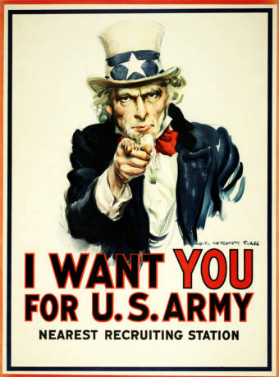
1. I Want YOU for U.S. Army, James
Montgomery Flagg, 1917
Originally published as a magazine cover in July 1916, this
portrait of "Uncle Sam" is considered to be one of the most popular
and iconic posters in history. As the United States entered World War I and
began sending troops and supplies overseas, more than four million copies were
printed and distributed across the nation.

2. We don't promise you a rose
garden, 1971
Featuring a menacing photograph
of former Marine drill instructor Sgt. Charles Taliano, this legendary poster
reminded prospective Marines of the harsh reality of service, and was a staple
of Marine recruiting offices from the early 1970s until the mid-1980s.
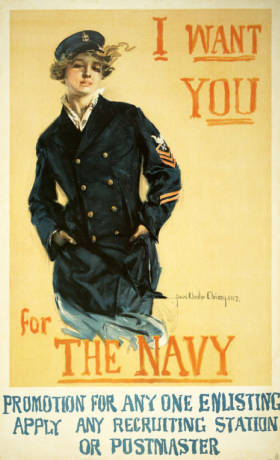
3. I Want You for the Navy, Howard
Chandler Christy, 1917
Christy is remembered best for
his "Christy Girls" -- drawings and paintings of women who possessed certain
characteristics that he believed represented the American Ideal -- and they
were present even in his work for the military. Here, Christy portrays a woman
wearing a navy coat and hat in a promotion for the U.S. Navy.
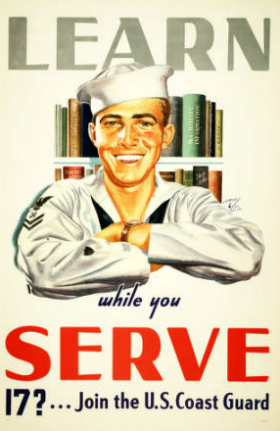
4. Learn While You Serve, John
Joseph Floherty, circa 1939-1945
The U.S. Coast Guard took a shot
at recruiting high school students with this WWII-era poster, which features a smiling
petty officer in front of two shelves of books on various engineering and naval
topics. The subheading, "17?...Join the U.S. Coast Guard," was intended to
capture the attention of young men contemplating higher education.
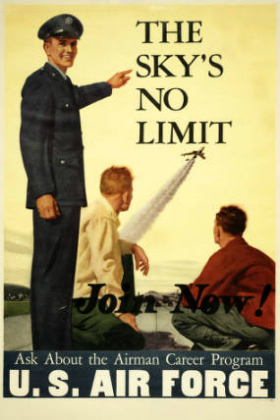
5. The Sky's No Limit, Harry
Anderson, 1950
While many recruitment posters
focus on duty or service, the U.S. Air Force had another angle to pitch: the
miracle of flight. In 1950, Harry Anderson's "The Sky's No Limit" poster
promised excitement and adventure to those who might become Air Force aviators.
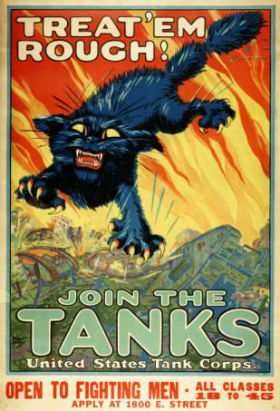
6. Treat ‘Em Rough - Join the Tanks, August
William Hutaf, 1917
The United States Tank Corps -- the
mechanized unit that conducted tank warfare during WWI -- produced one of the
most vivid and imaginative recruitment posters in history with this memorable
image of a fearsome black cat above a tank-strewn battlefield.
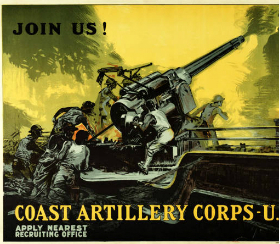
7. Coast Artillery Corps - U.S.A.,
Philip Lyford, 1926
In the tradition of most
recruitment posters of the early 20th century, the Army's Coast Artillery Corps
stuck to the basics in promoting their cause: "Join us!"
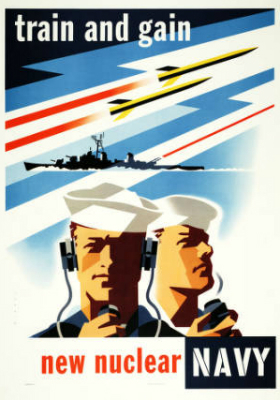
8. Train and Gain -- New Nuclear
Navy, Joseph Binder, 1958
The U.S. "Nuclear Navy" began to
take shape in the 1940s under Admiral (then Captain) Hyman Rickover, and was
officially established in 1954 with the launch of the U.S.S. Nautilus. This
poster features a modernistic design and an emphasis on advancement -- one of
the more appealing aspects of the transition to a futuristic power supply for
the U.S. Navy.
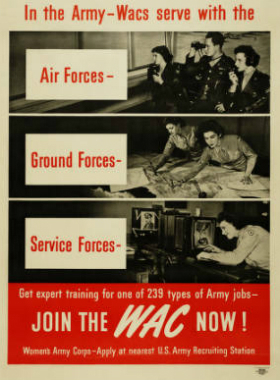
9. Join the WAC now!, 1944
The Women's Army Corps (WAC) was
created as an auxiliary unit in the early 1940s, and about 150,000 women served
within its ranks by the end of WWII. These female enlistees were given
opportunities to contribute to the war effort by supporting the Army's air
forces, ground forces, and service forces by learning one of more than 200
jobs.
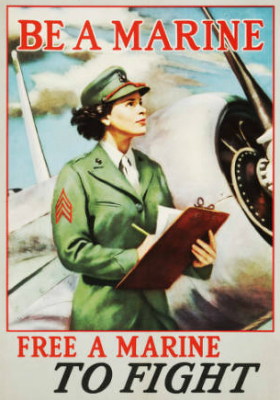
10. Be a Marine: Free a Marine to
Fight, circa 1939-1945
The U.S. Marine Corps joined the
WAC in recruiting and training women to perform certain duties that would
enable more male soldiers to deploy to the front lines. Although these types of
posters may be viewed as degrading by today's standards, they represent an
important step in the continuing quest for gender equality.
October 25, 2013
Help him out: He's invited to speak at his old high school on Veterans Day. What do Best Defense readers think he should say?

That's what a reader writes in to ask.
Here are the details:
--
"I am a post-9/11 Millennial generation Iraq War veteran
who served four years on active duty and two and counting as an active
reservist, all as a company grade/junior officer, and I am presently attending
graduate school on the G.I. Bill. I have been asked to return to my
hometown to speak at my high school to an audience of faculty, staff, ~1,200
students (some of whom have already or will soon enlist or go on to ROTC in
college), a delegation of local National Guard personnel, and veterans from
World War II through Afghanistan. I think it's important to impart
something more than the usual patriotic routine, but I would value the wisdom
of your readers in helping to tailor that message -- and I suspect the discussion
that would follow would be worthwhile on its merits."
--
If I were him, I would talk about the role
the vet plays in protecting the American experiment, the sense that our nation
is always changing, and about other ways to ensure that this noble experiment
does not perish from the earth, such as showing toleration and even
appreciation for those one disagrees with politically. I might end with a warning
against being absolutely certain on any political issue, and ask my listeners
to keep in mind Cromwell's admonition: "I
beseech you, in the bowels of Christ, think it possible that you may be
mistaken."
But that's just me. If you were invited back to your
old high school to speak on Veterans' Day, what would you say? (Besides, "Why
didn't Debbie Do-right go out with me?")
Best Defense commenters: Are you having problems with the FP paywall system?

"Victor LEsperance" commented today: "On a totally
unrelated topic, it sounds like the IT folks at Foreign Policy are moonlighting
at the Obamacare sight. I know they still have their day jobs because I
get paywalled on a regular basis despite coughing up for a
subscription. Now the general public has an idea of what it is like
to be a Foreign Policy subscriber and
sometime blog commenter."
I asked
the powers that be. One responded, "Our website is
undergoing a very extensive redesign, which among other things will bring
improvements to our commenting system, including single sign on. That means the
paywall glitches should come down -- way down - once the new site is up and
running. It shouldn't be long, now."
In the meantime, if
you are having problems, e-mail:
Be polite, OK? We don't want to give Best Defense readers
a bad rep at FP.
Speaking of Obamacare, don't compare it
to the ideal, compare it to what exists now. As part of my move to the New
America Foundation, I've spent a big part of the last six weeks trying to sort
out health insurance for my family. It is nuts. You never get anyone on the
phone the first time. They don't answer e-mails. They get back to you with
additional questions-a week later. They keep pulling out rules they didn't tell
me about when I needed to know them two years ago. And I have been paying a ton
of money for the privilege of receiving this pattern of neglect and abuse.
So, for all its frustrations, I will
take Obamacare. If I were younger, I'd consider setting up a company to guide
people through it.
Rebecca's War Dog of the Week: On the scene of Brazil's protests

By Rebecca Frankel
Best Defense Chief Canine Correspondent
Postcard from Brazil
Brazil has had its fair share of protests these last few
months -- the teachers'
protest that began in August, and now the protests against oil exploration
contracts. In this photo, taken in June, a protester is arrested by military
police from the special unit Chope, during clashes in the center of Niteroi, 10
kms from Rio de Janeiro. In the background of this chaotic scene, you can see
one of Brazil's military police dogs. Apparently,
Brazil integrated dogs into their armed forces in the 1960s, " authorized
their use within the Military Police organizations of the Army during jungle
operations and commando activities, and the Airborne Infantry Brigade." As
to the job of the dog in this photo, I would assume, based on the dog's breed
(a shepherd) and the situation (a charged protest), that he is there for one
thing -- crowd control.
October 24, 2013
'War Play': A Brilliant & Refreshing Study of the U.S. Military’s Use of Video Games
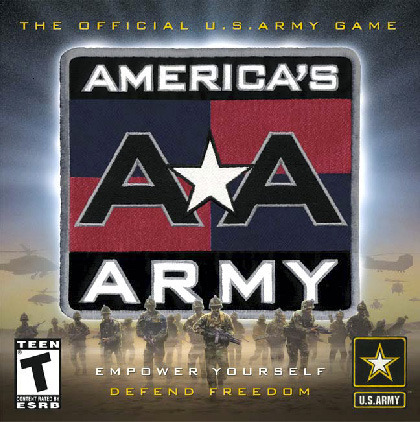
By Jim Gourley
Best Defense all-star team
Sometimes we can stare at a problem
until we lose perspective of its framework. In the contemporary debates over
drone warfare and domestic surveillance, all our focus is drawn to tangential
arguments such as confirmation of signatures and posse comitatus, distracting
us from essential fundamental considerations. How do the values of our armed
forces inform their relationship to technology? How does our sense of moral
obligation to allies and enemies extend into the virtual
world and the conduct of cyber warfare? Just how reliant is society on
the military for its security, and how reliant is the military on society for
its dominance in innovative capacity? When does the balance of those needs
necessitate the military's influence on the direction of civilian society?
These questions are somewhat esoteric, but they shape the underlying philosophy
that guides our most important decisions.
They
are also the ones that get shoved into the background of more immediate
matters. That is what makes Corey Mead's War Play such a
brilliantly refreshing work. Though its subject, the history of the military's
use of video games, seems innocuous, Mead provides a revealing historical
perspective that calls attention to its importance, benefits and consequences
all at once. Like an actual video game, War Play gives the reader an
opportunity to disconnect from "real world" concerns and enjoy
viewing things in a lighter, more entertaining context. But also like its
subject, War Play is much closer to the real thing than one might
expect, and shows how the same dilemmas apply to both Stuxnet and "America's Army."
At a
svelte 198 pages, this book wastes no time with extraneous commentary. From the
beginning, Mead launches
into the history of the military's and video game industry's influence on each
other. Interestingly, this relationship begins with the military's long-running
involvement in the American education system. He paints a picture of a large
governmental agency that created numerous materials and programs for war that
were repurposed into highly successful civilian applications. That agency in
turn often uses those products as leverage to access potential service members,
both for the purpose of recruitment and educational preparation. According to
Mead, it began when George Washington initiated a literacy program in Valley
Forge using the Bible as its textbook, and continues today as the military
introduces video simulations of firing ranges and missile launchers to schools
to help with physics-- and put military-themed materials in front of kids in
schools that are otherwise hostile to recruiters.
Perhaps
the most revelatory part of the book is the section Mead dedicates exclusively
to the video game "America's Army." From the genesis of its concept, to the
bitter arguments from military programmers that emphasizing Army values would
make the game unappealing to kids and efforts by the Pentagon to defund it, to
its achievement as the greatest recruiting tool in Army history and further
commercial success, Mead uses the story of this single game as a microcosm of
his entire narrative, and by proxy for the military's relationship with
technology as it enters the 21st century.
The
work is not without its flaws. At times Mead leaps to conclusions outside the
concern of his primary theses and without substantiating evidence. He claims
more than once that the modern video game
industry would not be as sophisticated or large as it is were it not for
the enormous amount of patronage it received from the military. It's a bit of a
reach without any consideration of other forces in the game industry, like a
certain Italian plumber from
Japan. Likewise, Mead is given to singing the praises of the modern
gamer-cum-soldier rather than scrutinizing him. He discusses the psychological
advantages a gamer has in the modern dynamic battlefield environment --
multitasking, greater ability to think quickly and filter sensory input-- only
in the context of actual hostilities. He does not question whether a
gamer-warrior is more or less adept at the more common tasks associated with
COIN.
But
these are momentary lapses. In the grand scheme of the work, Mead never forgets
that the important items are those that connect games to every other
defense-related tech endeavor. He drives this message home when he pivots on a
quotation from Orson Scott Card's masterpiece Ender's Game,
acknowledging the dilemma that arises when we make games more like war, war
more like games, and encourage children to play games all at once. Like many
other technological enterprises within the Defense Department, the history of
games' successes and failures is haphazard and demonstrates a lack of a
cohesive strategy aimed at clear objectives, making the future vulnerable and
the military its own worst enemy. This is War Play 's greatest
achievemen t-- an examination of a process unblemished by debates attached to
the product. In that regard, it may be as valuable to the present state of
controversial technologies as it is prescient of future ones.
Tom
says
Jim Gourley
is
a force of nature
.
Did the Bay of Pigs Attack Go Off Track Because It Was Supposed to Kick Off With The Assassination of Fidel Castro?

I've just finished reading Seymour
Hersh's very interesting book The
Dark Side of Camelot. He argues that the Bay of Pigs invasion went wrong in part
because Castro was supposed to be killed by the time it started. When that
didn't happen, the whole shebang
began unraveling.
I wish I had read the book before I
wrote about Maxwell Taylor in my own book The
Generals. Hersh confirms my view that Taylor was a snake, and that the
Kennedys (John and Robert) were taken in by him -- and that is one of the
reasons we wound up in Vietnam, as they all showed each other how tough they
were, and Taylor thought he had found a role for the Army in a nuclear
world.
Thomas E. Ricks's Blog
- Thomas E. Ricks's profile
- 436 followers



